12.4 Trait Theories
LOQ 12-
Trait a characteristic pattern of behavior or a tendency to feel and act in a certain way, as assessed by self-
Freudian and humanistic theories shared a common goal: Explain how our personality develops. They focused on the forces that act upon us. Trait researchers, led by the work of Gordon Allport (1897–
Exploring Traits
360
Imagine that you’ve been hired by an online dating service. Your job is to construct a questionnaire for a new app that will better help people describe themselves to those seeking dates and mates. With millions of people using such services each year, the need to understand and incorporate psychological science grows more important (Finkel et al., 2012a,b). What personality traits might give an accurate sense of the person filling out your questionnaire? You might begin by thinking of how we describe a pizza. We place a pizza along several trait dimensions. It’s small, medium, or large; it has one or more toppings; it has a thin or thick crust. By likewise placing people on trait dimensions, we can begin to describe them.

Basic Factors
factora cluster of behavior tendencies that occur together.
An even better way to identify our personality is to identify factors—
So how many traits will be just the right number for success with your dating questionnaire? If psychologists Hans Eysenck and Sybil Eysenck [EYE-
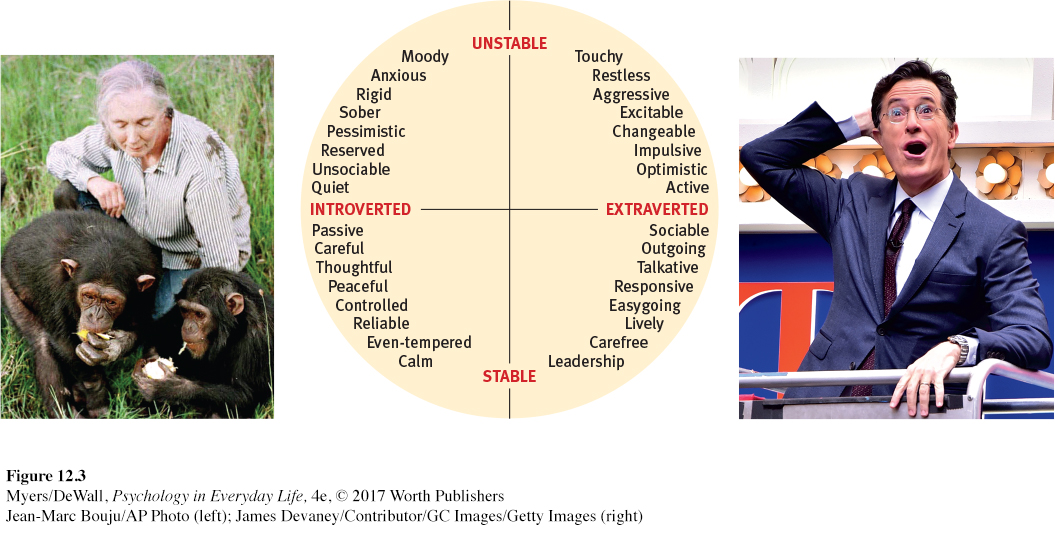
Biology and Personality
As you may recall from the twin and adoption studies discussed in Chapter 3, our genes have much to say about the temperament and behavioral style that help define our personality. Children’s shyness, for example, seems related to differences in their autonomic nervous systems. Infants with reactive autonomic nervous systems respond to stress with greater anxiety and inhibition (Kagan, 2010).
361
LOQ 12-
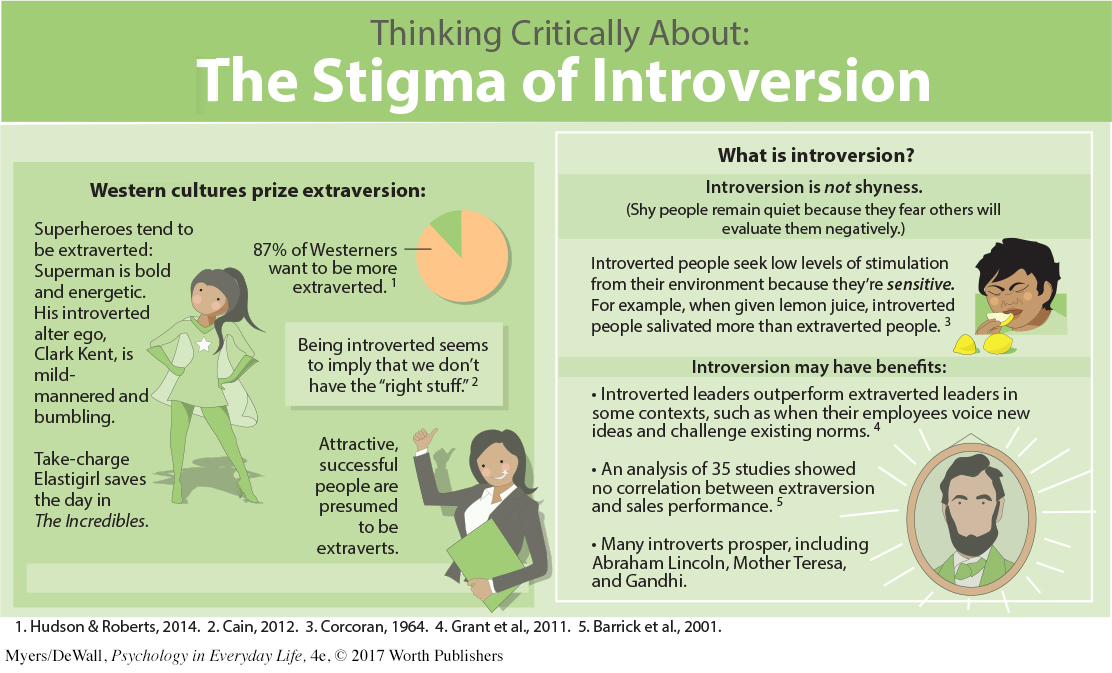

Brain activity appears to vary with personality as well. Brain-
Personality differences among dogs are as obvious to researchers as they are to dog owners. Such differences (in energy, affection, reactivity, and curious intelligence) are as evident, and as consistently judged, as personality differences among humans (Gosling et al., 2003; Jones & Gosling, 2005). Monkeys, bonobos, chimpanzees, orangutans, and even birds also have stable personalities (Weiss et al., 2006, 2015). Among the Great Tit (a European relative of the American chickadee), bold birds more quickly inspect new objects and explore trees (Groothuis & Carere, 2005; Verbeek et al., 1994). Through selective breeding, researchers can produce bold or shy birds. Both have their place in natural history. In lean years, bold birds are more likely to find food; in abundant years, shy birds feed with less risk.
Retrieve + Remember
Question 12.8
•Which two primary dimensions did Hans Eysenck and Sybil Eysenck propose for describing personality variation?
ANSWER: introversion–
Assessing Traits
LOQ 12-
Minnesota Multiphasic Personality Inventory (MMPI) the most widely researched and clinically used of all personality tests. Originally developed to identify emotional disorders (still considered its most appropriate use), this test is now used for many other screening purposes.
personality inventory a questionnaire (often with true-
It helps to know that a potential date is an introvert or an extravert, or even that the person is emotionally stable or unstable. But wouldn’t you like more information about the test-
362
 IMMERSIVE LEARNING Might astrology hold the secret to our personality traits? To consider this question, visit LaunchPad’s How Would You Know If Astrologers Can Describe People’s Personality?
IMMERSIVE LEARNING Might astrology hold the secret to our personality traits? To consider this question, visit LaunchPad’s How Would You Know If Astrologers Can Describe People’s Personality?
The Big Five Factors
LOQ 12-
Today’s trait researchers rely on five factors (called the Big Five) to understand personality—
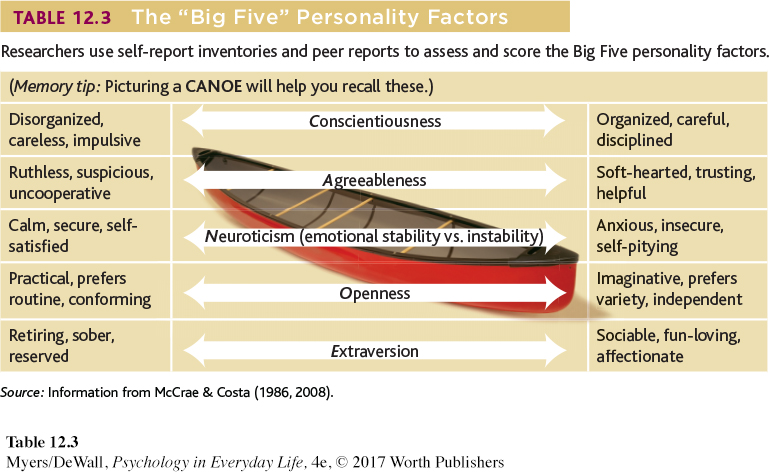
As the dominant model in personality psychology, Big Five research has explored various questions:
How stable are these traits? One research team analyzed 1.25 million participants ages 10 to 65. They learned that personality continues to develop and change through late childhood and adolescence. By adulthood, our traits have become fairly stable, though conscientiousness, agreeableness, openness, and extraversion continue to increase over the life span, and neuroticism (emotional instability) decreases (Soto et al., 2011).
Do we inherit these traits? Roughly 40 percent of our individual differences on the Big Five can be credited to our genes (Vukasovic´ & Bratko, 2015).
Do these traits reflect differing brain structure or function? The size of different brain regions does correlate with several Big Five traits (DeYoung et al., 2010; Grodin & White, 2015). For example, those who score high on conscientiousness tend to have a larger frontal lobe area that aids in planning and controlling behavior. Brain connections also influence the Big Five traits (Adelstein et al., 2011). People high in openness have brains that are wired to experience intense imagination, curiosity, and fantasy.
Have levels of these traits changed over time? Cultures change over time, which can influence shifts in personality. Within the United States and the Netherlands, extraversion and conscientiousness have increased over time (Mroczek & Spiro, 2003; Smits et al., 2011; Twenge, 2001).
How well do these traits apply to various cultures? The Big Five dimensions describe personality in various cultures reasonably well (Schmitt et al., 2007; Vazsonyi et al., 2015; Yamagata et al., 2006). After studying people from 50 cultures, Robert McCrae and 79 co-
researchers concluded that “features of personality traits are common to all human groups” (2005). Do the Big Five traits predict our actual behavior? Yes. For example, our traits appear in our language patterns. In blog posts, extraversion predicts use of personal pronouns (we, our, us). Agreeableness predicts positive-
emotion words. Neuroticism predicts negative- emotion words (Yarkoni, 2010).
To find out how your personality measures up, try the brief self-
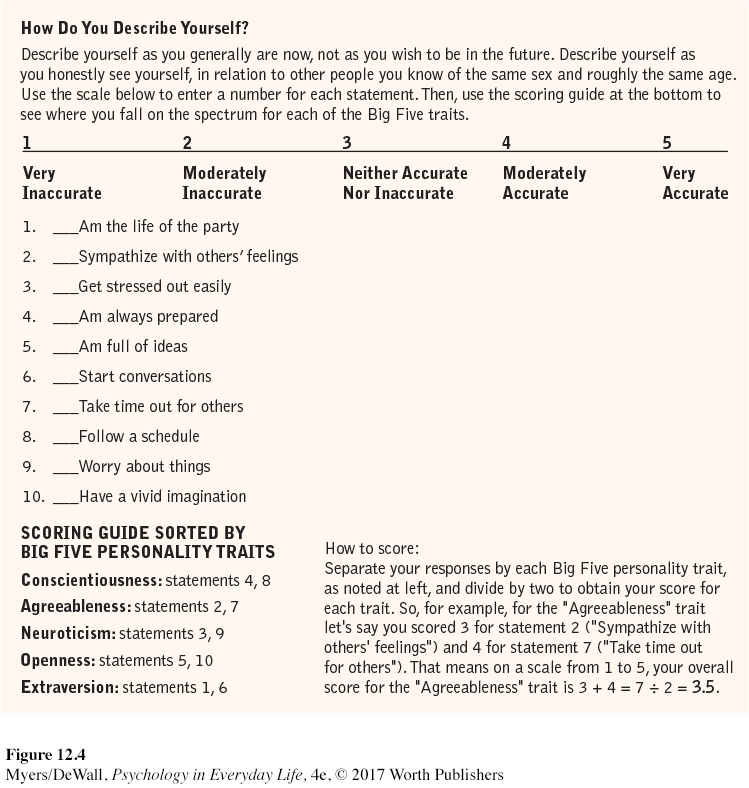
 For an 8-
For an 8-
363
Retrieve + Remember
Question 12.9
•What are the Big Five personality factors, and why are they scientifically useful?
ANSWER: The Big Five personality factors are conscientiousness, agreeableness, neuroticism (emotional stability vs. instability), openness, and extraversion (CANOE). These factors may be objectively measured, they are relatively stable across the life span, and they apply to all cultures in which they have been studied.
Evaluating Trait Theories
LOQ 12-
To be useful indicators of personality, traits would have to persist over time and across situations. Friendly people, for example, would have to act friendly at different times and places. In some ways, our personality seems stable. Cheerful, friendly children tend to become cheerful, friendly adults. But it’s also true that a fun-
The Person-Situation Controversy
Many researchers have studied personality stability over the life span. A group of 152 long-
As we grow older, our personality traits stabilize. Interests may change—
The consistency of specific behaviors from one situation to the next is another matter. People are not always predictable. What relationship would you expect to find between being conscientious on one occasion (say, showing up for class on time) and being conscientious on another occasion (say, avoiding unhealthy foods)? If you’ve noticed how outgoing you are in some situations and how reserved you are in others, perhaps you said, “Very little.” That’s what researchers have found—
If we remember such results, we will be more careful about labeling other people (Mischel, 1968, 2004). We will recognize how difficult it is to predict whether someone is likely to violate parole, commit suicide, or be an effective employee. Years in advance, science can tell us the distance of the Earth from the Sun for any given date. A day in advance, meteorologists can often predict the weather. Yet psychologists have not yet solved the riddle of how you will feel and act tomorrow, or even a few hours from now.
364
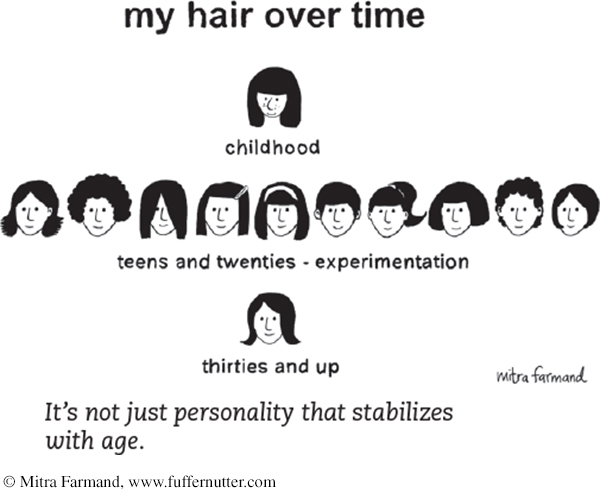
Does this mean that psychological science has nothing meaningful to say about personality traits? No! Remember that traits do a good job at predicting people’s average behavior (outgoingness, happiness, carelessness) over many situations (Epstein, 1983a,b).
Even when we try to restrain them, our traits may assert themselves. During my [DM] noontime pickup basketball games with friends, I keep vowing to cut back on my jabbering and joking. But without fail, the irrepressible chatterbox reoccupies my body moments later. I [ND] have a similar experience each time I try to stay quiet when riding in taxis, but somehow always end up chatting!
Our personality traits lurk in some unexpected places.
Music preferences: Your playlist says a lot about your personality. Classical, jazz, blues, and folk music lovers tend to be open to experience and verbally intelligent. Extraverts tend to prefer upbeat and energetic music. Country, pop, and religious music lovers tend to be cheerful, outgoing, and conscientious (Langmeyer et al., 2012; Rentfrow & Gosling, 2003, 2006).
Written communications: Have you ever felt you could detect others’ personality from their writing voice? You are right!! What a cool finding!!! ☺ From people’s writing we can predict their levels of extraversion, neuroticism, and agreeableness (Gill et al., 2006; Park et al., 2015; Pennebaker, 2011). For example, those who score high in extraversion draw attention to themselves by using more first-
person singular pronouns (I and me). Those high in neuroticism use more negative emotion words. And those high in agreeableness use fewer swear words. Online and personal spaces: Online profiles, blogs, websites, instant messaging accounts, and avatars are also a canvas for self-
expression. People who seem most likeable on their Facebook page also seem most likeable in face- to- face meetings (Weisbuch et al., 2009). Your online self may indeed reflect the real you! Our living and working spaces also help us express our identity. They all offer clues to a person’s extraversion, agreeableness, conscientiousness, and openness (Back et al., 2010; Fong & Mar, 2015; Gosling, 2008). Even mere photos, with their associated clothes, expressions, and postures, can give clues to personality (Naumann et al., 2009).

In unfamiliar, formal situations—
To sum up, we can say that the immediate situation powerfully influences our behavior, especially when the situation makes clear demands (Cooper & Withey, 2009). We can better predict drivers’ behavior at traffic lights from knowing the color of the lights than from knowing the drivers’ personalities. Averaging our behavior across many occasions does, however, reveal distinct personality traits. Traits exist, and they leave tracks in our lives. We differ. And our differences matter.
Retrieve + Remember
Question 12.10
•How well do personality test scores predict our behavior? Explain.
ANSWER: Our scores on personality tests predict our average behavior across many situations much better than they predict our specific behavior in any given situation.